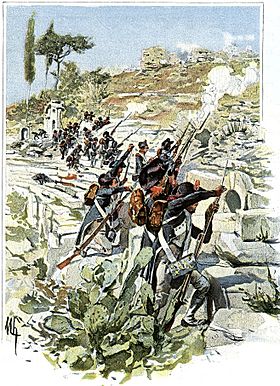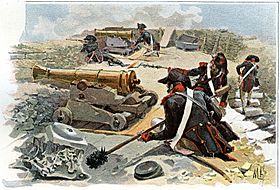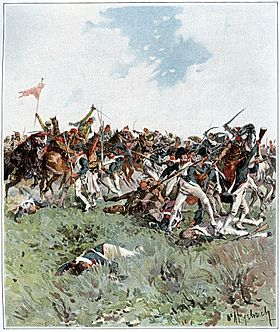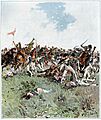Battle of Nicopolis (1798) facts for kids
Quick facts for kids Battle of Nicopolis |
|||||||
|---|---|---|---|---|---|---|---|
| Part of the War of the Second Coalition | |||||||
 French troops fighting amidst the ruins of the ancient theatre of Nicopolis, painting by Felician Myrbach |
|||||||
|
|||||||
| Belligerents | |||||||
| Revolutionary France | Pashalik of Janina | ||||||
| Commanders and leaders | |||||||
| Jean Jacques Bernardin Colaud de La Salcette (POW) | Ali Pasha of Janina | ||||||
| Strength | |||||||
| 440 French troops (other accounts: 300–600) 260 Prevezan civil guards and Souliotes (other accounts: up to 600) |
4,000 infantry and 3,000 cavalry; eyewitness estimates 10,000–15,000 men | ||||||
| Casualties and losses | |||||||
| Heavy; 157 soldiers taken prisoner, many soldiers and civilians massacred | Unknown | ||||||
The Battle of Nicopolis was a fight on October 23, 1798. It happened between French soldiers and the army of Ali Pasha of Janina, a powerful local ruler in what is now Albania and Greece.
The year before, France had taken control of the Venetian Ionian Islands off the western coast of Greece. These islands also included some areas on the mainland, like Butrint and Preveza. Ali Pasha wanted these mainland areas for himself.
The French tried to get Ali Pasha to join them against the Ottoman Sultan, but it didn't work. When the Ottoman Empire decided to fight France, Ali Pasha attacked the French positions. The battle took place near the old city of Nicopolis. The French lost, and the town of Preveza was badly damaged afterwards.
Contents
Why Did the Battle of Nicopolis Happen?
At the end of the 1700s, the Ionian Islands (like Corfu and Zakynthos) and a few towns on the mainland, such as Parga and Preveza, were owned by the Republic of Venice. In 1797, Napoleon Bonaparte and his French forces ended the Venetian Republic. French soldiers then took over these islands and mainland towns.
Who Was Ali Pasha?
The new French leaders were very interested in their powerful neighbor, Ali Pasha of Janina. He was a semi-independent ruler of a large area called the Pashalik of Janina, which covered much of modern-day Albania and mainland Greece.
Both sides first tried to be friends. French leaders met with Ali Pasha, and French visitors often went to his court. Ali Pasha seemed friendly and even pretended to like French ideas. However, his main goal was to get the mainland towns that the French now controlled. The French refused to give them up.
Why Did Ali Pasha Attack?
The French also failed to convince Ali Pasha to openly oppose the Ottoman Sultan. When Napoleon's invasion of Egypt happened, Ali Pasha became worried about what France really wanted.
Even though the French in the Ionian Islands thought Ali Pasha was their friend and would protect them, Ali Pasha decided to side with the Sultan. This decision was made especially after the French lost the Battle of the Nile.
In July 1798, the Ottoman Empire and the Russian Empire formed an alliance against France. After declaring war, a combined Ottoman–Russian fleet sailed towards the Ionian Islands. Ali Pasha gathered his soldiers near Butrint. He sent letters to the French governor, demanding not only the mainland towns but also Corfu itself.
Ali Pasha's forces first attacked Butrint, capturing it after a week of hard fighting on October 25. The French blew up their forts and left for Corfu, taking Greek residents with them. Ali Pasha then moved to Preveza, arriving on October 22 with his son, Mukhtar Pasha.
Who Fought in the Battle of Nicopolis?
The French forces in Preveza were led by General Jean Jacques Bernardin Colaud de La Salcette. The exact number of French soldiers is not fully clear, but it was likely between 380 and 460 men. They were joined by local fighters from Preveza and some Souliotes, who were a group of fierce Greek fighters.
French Soldiers and Their Allies
The most reliable numbers suggest there were 440 French soldiers. This included 381 soldiers from two infantry regiments, 41 engineers, and 18 artillerymen (who operated cannons). They were supported by 200 people from Preveza and 60 Souliotes. The Souliotes were led by Christakis Kalogeros.
French Fortifications
The main fort in Preveza was the Castle of Saint Andrew. It was small, old, and not very strong because nearby houses were taller than its walls. When the French took over, they found only a few guards and cannons there.
Knowing an attack was coming, the French started building new defenses at the narrow strip of land leading to Preveza, where the ancient city of Nicopolis once stood. This work was led by Captain Louis-Auguste Camus de Richemont. In about two weeks, the French built two square forts (called redoubts) on two small hills.
The left redoubt, facing the Ionian Sea, was probably bigger and used as the main command post. It had three old cannons and 80 soldiers. The right redoubt, facing the Ambracian Gulf, was commanded by Richemont and had two cannons. The French also planned to build fences and trenches, but it's not clear how much of this was finished. It seems they fought from five separate trenches.
Ali Pasha's Army
The size of Ali Pasha's army is also uncertain, with estimates ranging from 4,000 to over 20,000 men. French soldiers who were there reported the Albanian army had between 10,000 and 15,000 men. Most sources say around 11,000. Other historians suggest a more detailed breakdown of 4,000 foot soldiers and 3,000 cavalry (soldiers on horseback). Ali Pasha set up his camp on a hill called Michalitsi, which gave him a good view of the battlefield.
How the Battle of Nicopolis Unfolded
The exact details of the battle are not completely clear, as different accounts give different parts of the story.
On the night of October 22/23, the Albanians started firing their guns and shouting loudly. General La Salcette and Captain Richemont quickly went from Preveza to their forts to take command. Fifty French soldiers stayed in Preveza to keep order, and another fifty were placed outside the city to protect a possible French retreat.
The first attack was launched by 500 Albanians led by Mukhtar Pasha. Around this time, some of the Souliotes and Prevezans who were helping the French left the lines and escaped by boat to the Ionian Islands.
Around 3:00 AM, the fighting started again and continued until morning. Two French companies (groups of soldiers) fought back and pushed the Albanians towards the ancient theatre of Nicopolis. However, after a French commander was killed, the Albanians used the confusion to push the French back.
La Salcette ordered his men to return to their original positions, but this was difficult because of the rough ground and the constant pressure from the Albanians. Around 8:00 AM, Ali Pasha sent the main part of his army against the French. The French held their ground for a couple of hours, but then Ali Pasha's cavalry charged and broke their lines. The battle turned into close-quarters fighting.
The local Prevezans in the center, helped by French cannons, caused many losses for the attackers. But after some of their officers ran away, they also broke apart. As a result, the right redoubt (fort) was surrounded and captured. Richemont was captured while trying to reach the left redoubt, which was still fighting.
With the right side of the French line broken, the way to Preveza was open, and many Albanian soldiers rushed towards the town. After a while, the left redoubt also fell, and La Salcette was taken prisoner.
Captain Jean-Marie Tissot and 80 of his men tried to rescue their commander. They moved quickly through the ruins of Nicopolis, fighting off cavalry attacks. But they were eventually stopped by Albanian foot soldiers and had to slowly retreat while fighting. On the far right of the French line, the Prevezans and Souliotes were still fighting until noon. Then, the Albanians left them and Tissot's group to capture Preveza.
In Preveza, the small French group in the Castle of Saint Andrew was quickly defeated. Tissot and his men eventually fought their way into the town, only to find the Albanians in control. They went to the home of the French consul, Pierre-Jérôme Dupré, and held their ground for a few hours against repeated attacks, with their backs to the sea. They hoped for help from a French gunboat, but the boat's captain, thinking no French had survived, sailed away. Tissot's group kept fighting, allowing many Prevezan civilians to escape by sea. Finally, exhausted and out of ammunition, Tissot's men were captured around 3:30 PM.
What Happened After the Battle?
After taking Preveza, Ali Pasha had the people who supported the French publicly killed and burned the town. He then tricked the Prevezans who had fled to Aktion into returning by promising them safety. Instead, he had them beheaded.
The town of Vonitsa surrendered soon after Preveza fell. Only Parga managed to resist Ali Pasha's forces. Preveza remained under Ali Pasha's control until 1800. At that time, the Ionian Islands became a shared territory between Russia and the Ottoman Empire. As part of a peace treaty, Preveza and the other mainland towns came directly under Ottoman rule.
Later, during another war between Russia and the Ottoman Empire (1806–1812), Ali Pasha took control of Preveza again and put his son, Veli Pasha, in charge. This lasted until the Ottoman government turned against Ali Pasha in 1820. The last period of Ottoman rule in Preveza lasted from 1820 until 1912, when Greece captured the town during the First Balkan War.
General La Salcette, seven officers, and 149 other soldiers were taken prisoner. They were treated very harshly and paraded through the streets of Janina before being sent to Constantinople to show Ali Pasha's loyalty to the Sultan. Many prisoners, including La Salcette and Richemont, were held in the Yedikule Fortress in Constantinople. They met other French prisoners there, including the writer François Pouqueville, who later wrote about the battle based on what these eyewitnesses told him. Many prisoners died in captivity, but the remaining ones were set free in 1801.
Images for kids






